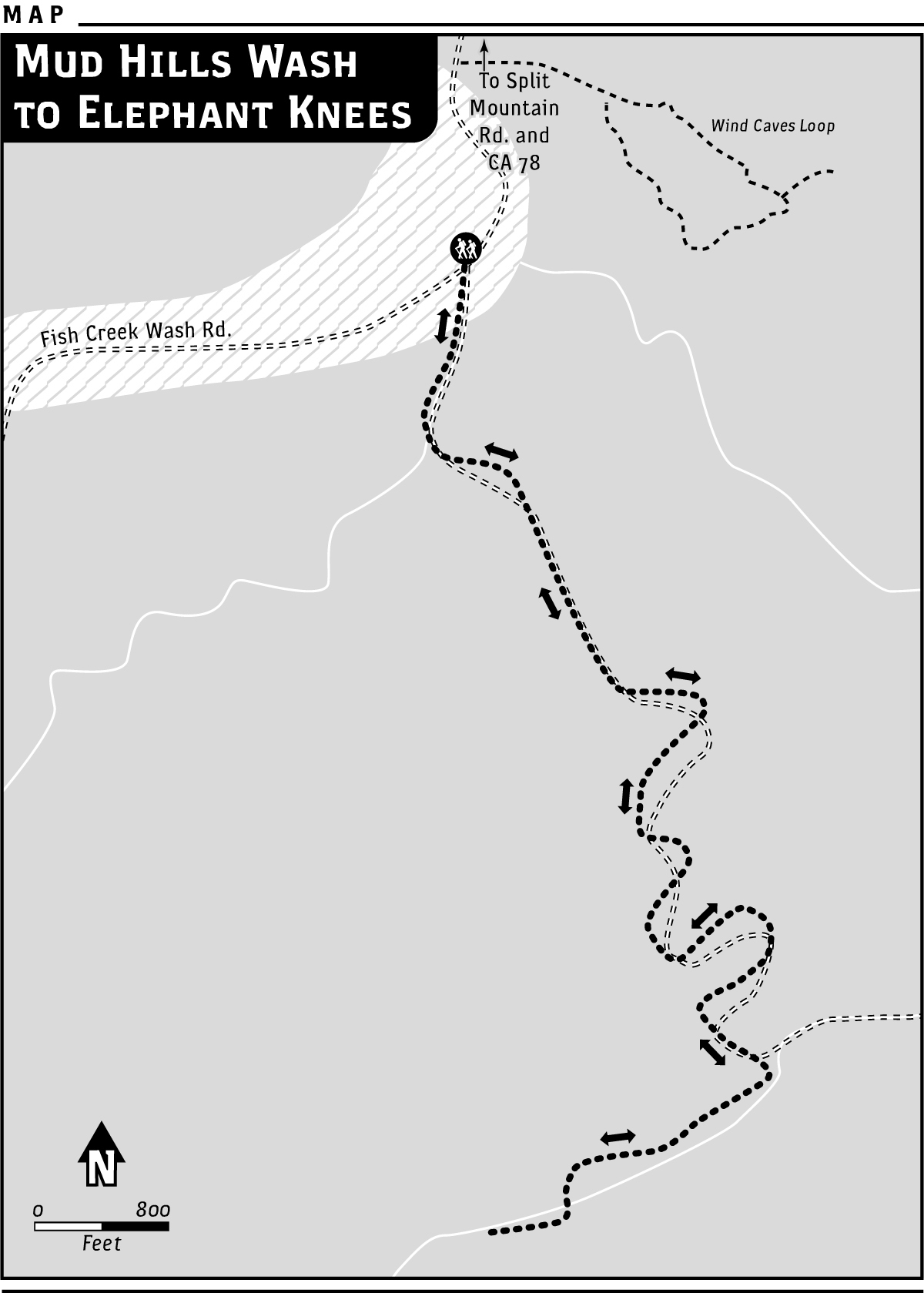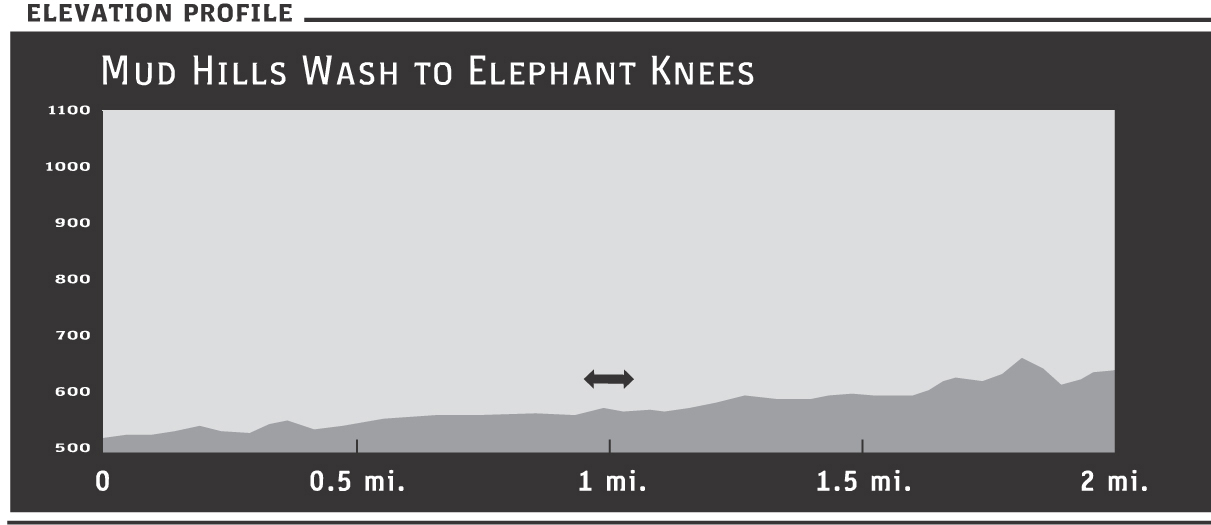27 Mud Hills Wash to Elephant Knees
SCENERY: 
DIFFICULTY: 
TRAIL CONDITION: 
SOLITUDE: 
CHILDREN: 
DISTANCE: 4 miles round trip
HIKING TIME: 2–3 hours
OUTSTANDING FEATURES: Mud hills, fossils, typical sandy-wash landscape, and the towering formation known as Elephant Knees
This easy out-and-back trip allows you to view fossils in plain sight, layered like cake in uplifted sandstone buttresses.
Directions: From CA 78 at Ocotillo Wells, head south on Split Mountain Road for approximately 8 miles. En route, pass the Elephant Trees Nature Loop turnoff (to the right) and continue to another dirt route on the right marked “Fish Creek Wash.” Drive up the wash (four-wheel drive recommended). Pass Wind Caves on the left at approximately 5 miles, and bear left (the north fork of Fish Creek Wash splits to the right). Mud Hills Wash is approximately 0.3 miles past the split (unmarked), on the left. You’ll recognize it by a sign reading “closed area,” barring vehicle use of the wash. Once you see a kiosk (also on the left) with information on the unusual dune formations, you’ll have gone too far. Park on the hard sand shoulder, where unmistakable Elephant Knees is visible to the southwest.
| GPS Coordinates | 27 MUD HILLS WASH TO ELEPHANT KNEES | |
| UTM Zone (WGS84) | 11S | |
| Easting | 582373 | |
| Northing | 3650518 | |
| Latitude–Longitude | N 32º 59’ 23.8121” | |
| W 116º 7’ 5.9571” |


 Enter the wash beyond the “closed area” sign barring all vehicles and you’ll immediately see the aptly named Elephant Knees to the southwest. The shell-reef buttress does in fact look like a series of elephant knees all in a row. The size and configuration is like something out of a Star Wars film.
Enter the wash beyond the “closed area” sign barring all vehicles and you’ll immediately see the aptly named Elephant Knees to the southwest. The shell-reef buttress does in fact look like a series of elephant knees all in a row. The size and configuration is like something out of a Star Wars film.
The sandy, mostly level wash moves between hills of mud that sparkle with bits of gypsum gleaming in the sun. In the dull mud, the crystalline gypsum glints like ancient treasure and hints at what’s to come—fossils some several millions of years old, remnants of the Gulf of California that at one time covered the area.
The route meanders a little, bending away from Elephant Knees, then back, away and back again. The hulky formation itself will be visible only part of the time beyond the hills of mud bordering the wash. Enjoy the immediate scenery, if not for its beauty, then for its unique qualities. The flaky surface of the dried mud hills holds a rough pattern, similar to elephant skin. An interesting plant found here is the desert trumpet, recognized by a bulging, inflated portion in its central stem. When dry in winter or summer, the perennial upright herb is drab brown with a bulbous stem and spindled head similar to an old television antennae or an invader from Mars. Spring through early fall, the green spindles sprout small yellow flowers above the trumpet-inflated stem and a spray of flat, green leaves.
At 1.6 miles, the main wash stretches to the left. Turn right here, accessing a narrower side route that quickly bends southwest, heading around the backside of Elephant Knees. The now-rockier path is littered heavily with the glassy gypsum. The trail forks at mile 1.8, paths splitting around some mud domes. Take the right fork.
What do the backs of elephants’ knees look like? Saggy and baggy may come to mind, but not in this case. The backside of Elephant Knees is drier and rockier than the buttress front, losing the “knees” form entirely. Here you’ll see layers and layers of embedded oyster and shrimp fossils. As you walk along, the fossil presence thickens, seemingly stirred into the land like slivered nuts in cookie dough. There are so many fossils that you’ll be walking on them, touching them all along the trail, and seeing them in the distance. Fragments are most common, although fully intact shells are also present en masse.
Visible fossils begin to thin, completely replaced by a more typical desert experience at around 2 miles. Rocky terrain dotted with bushy creosote, spindly ocotillo, and stout barrel cactus seems to have swallowed the mud hills and fossil-rich landscape—clues to ancient waters once present here and filled with sea life.
Retrace your steps to the main wash, then go left back to Fish Creek Wash, where you’ve parked. Before leaving, venture up to the kiosk west of the trailhead for a quick study of the Gulf of California while overlooking the rolling mud dunes.